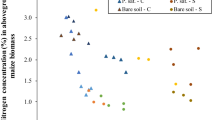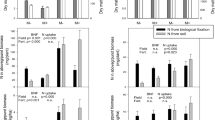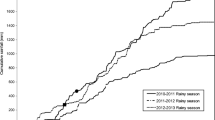Abstract
Three woody legumes were planted as two-year `improved fallows' to evaluate their residual nitrogen (N) effects on two subsequent maize crops under minimum and conventional tillage management. Maize monoculture and cowpea-maize-maize sequence treatments were included as controls. N2-fixation was estimated using the 15N natural abundance method to allow the N contribution from the fallows to be partitioned into N2-fixation and soil N capture. Acacia angustissima accumulated the largest amount of both below-ground and above-ground biomass during the 2-year growth period. Using Hyparrhenia grass as the reference plant, the proportion of N2-fixed in litter was 56, 55, 84 and 58% for Acacia, Sesbania sesban, Cajanus cajan, and cowpea, respectively, resulting in inputs of biologically fixed N of 122, 84, 96 and 28 kg N ha−1. Maize growth following the legumes for two subsequent cropping seasons was in most cases not directly related to the N inputs. The first year maize crop was severely infested with cutworms (Agrotis sp.) in the Sesbania and Acacia plots, while the second season maize was affected by drought particularly in the Acacia plots where there was high moisture demand by the re-growing trees. During the second season, N uptake by maize following Sesbania was significantly higher than the rest of the treatments. Conventional tillage resulted in better yields than minimum tillage across all treatments and in both seasons. It can be concluded that (1) improved legume fallow system results in net positive soil N balances, (2) despite large inputs of litter and continued recycling of N during the cropping phase, legume species that re-grow after cutting can result in depressed yields in drought seasons, and (3) tillage is beneficial even after improved legume fallows.
Similar content being viewed by others
References
Bala A and Giller K E 2001 Symbiotic specificity of tropical tree rhizobia for host legumes. New Phytol. 149, 495–507.
Boddey R M, Peoples M B, Palmer B and Dart P J 2000 Use of the 15N natural abundance method to quantify biological nitrogen fixation by woody perennials. Nutr. Cycl. Agroecosyst. 57, 235–270.
Bromfield E S P and Kumar Rao J V D K 1983 Studies on fast and slow growing Rhizobiumspp. nodulating Cajanus cajanand Cicer arietinum. Ann. Appl. Biol. 102, 485–493.
Chikowo R, Mapfumo P, Nyamugafata P, Nyamadzawo G and Giller K E 2003 Nitrate-N dynamics following improved fallows and spatial maize root development in a Zimbabwean sandy clay loam. Agrofor. Syst. 59, 187–195.
Danso A A and Morgan P 1993 Alley cropping rice (Oryza sativa var. Barafita) with cassia (Cassia siamea): Soil fertility and crop production. Agrofor. Syst. 21, 147–158.
Gathumbi S M, Cadisch G and Giller K E 2002 15N natural abundance as a tool for assessing N2-fixation of herbaceous, shrub and tree legumes in improved fallows. Soil Biol. Biochem. 34, 1059–1071.
GENSTAT 1997 GENSTAT 5, Reference Manual. Ed. Payne R W. Rothamsted Experimental Station. Clarendon Press, Oxford Science Publications, UK.
Giller K E 2001 Nitrogen Fixation in Tropical Cropping Systems, 2nd edn. CAB International, Wallingford, UK. 423 pp.
Giller K E and Cadisch G 1997 Driven by nature: A sense of arrival or departure. InDriven by Nature: Plant litter Quality and Decomposition Eds. G Cadisch and K E Giller. pp. 393–399. CAB International, Wallingford, UK.
Giller K E, Cadisch G, Ehaliotis C, Adams E, Sakala W D and Mafongoya P L 1997 Building soil nitrogen capital in Africa. InReplenishing Soil Fertility in Africa. Eds. R J Buresh, P A Sanchez and F Calhourn. pp. 151-192. Soil Sci. Soc. Am. J. Spec. Publ. 51, Madison, WI.
Grant P M 1981 The fertilization of sandy soils in peasant agriculture. Zim. Agric. J. 78, 169–175.
Hairiah K, van Noordwijk M, Santoso B and Syekhfani M S 1992Biomass production and root distribution of eight trees and their potential for hedgerow intercropping on an ultisol in southern Sumatra. Agrivita 15, 54–68.
Hogberg P 1997 15N natural abundance in soil-plant systems. New Phytol. 137, 179–203.
Kwesiga F and Beniest J 1998 Sesbania improved fallows for eastern Zambia: An extension guideline. Nairobi. ICRAF.
Kwesiga F and Coe R 1994 The effect of short rotation Sesbania sesban planted fallows on maize yield. For. Ecol. Man. 64, 199–208.
Ledgard S F and Peoples M B 1988 Measurements of nitrogen fixation in the field. InAdvances in Nitrogen Cycling in Agricultural Ecosystems Ed. J R Wilson. pp. 351-367. CAB International, Wallingford, UK.
Mafongoya P L and Dzowela B H 1999 Biomass production of tree fallows and their residual effect on maize in Zimbabwe. Agrofor. Syst. 47, 139–151.
Mapfumo P, Giller K E, Mpepereki S and Mafongoya P L 1999 Dinitrogen fixation by pigeonpea of different maturity types on granitic sandy soils in Zimbabwe. Symbiosis 27, 305–318.
Nene Y L and Sheila U K 1990 Pigeonpea: Geography and importance. InThe Pigeonpea Eds. Y L Nene, S D Hall and U K Sheila. pp. 1-14. CAB International, UK.
Palm C A, Gachengo C N, Delve R J, Cadisch G and Giller K E 2001 Organic inputs for soil fertility management in tropical agroecosystems: Application of an organic resource database. Agric. Ecosyst. Environ. 83, 27–42.
Peoples M B, Faizah A W, Rerkasem B and Herridge D H 1989 Methods of evaluating nitrogen fixation by nodulated legumes in the field. Australian Centre for International Agricultural Research, Canberra.
Peoples M B, Palmer B, Lilley D M, Duc L M and Herridge D F 1996 Application of 15N and xylem ureide methods for assessing N2-fixation of three shrub legumes periodically pruned for forage. Plant Soil 182, 125–137.
Piha MI 1993 Optimizing fertilizer use and practical rainfall capture in a semi-arid environment with variable rainfall. Exp. Agric. 29, 405–415.
Reddy L J 1990 Pigeonpea: Morphology. InThe Pigeonpea. Eds. Y L Nene, S D Hall and U K Sheila. pp. 47–88. CAB International.
Ruhigwa B A, Gichuru M P, Mambani B and Tariah N M 1992 Root distribution of Acioa barteri, Alchornea cordifolia, Cassia siameaand Gmelina arboreain an acid Ultisol. Agrofor. Syst. 19, 67–78.
Sakala W, Cadisch G and Giller K E 2000 Interactions between residues of maize and pigeonpea and mineral N fertilizers during decomposition and N mineralization. Soil Biol. Biochem. 32, 699–706.
Sanchez PA and Palm C A 1996 Nutrient cycling and agroforestry in Africa. Unasylva 185. 47, 24–28.
Shearer G and D H Kohl 1986 N2-fixation in field settings: Estimations based on natural 15N abundance. Australian J. Plant Phys. 13, 699–756.
Singh R P, Ong C K and Saharan N 1989 Above and below ground interactions in alley-cropping in semi-arid India. Agrofor. Syst. 9, 259–274.
Torquebiau E and Kwesiga F 1996 Root development in Sesbania sesban fallow-maize system in eastern Zambia. Agrofor. Syst. 34, 193–211.
Unkovich M J, Pate J S, Sanford P and Armstrong E L 1994 Potential precision of the delta 15N natural abundance method in field estimates of nitrogen fixation by crop and pasture legumes in South-West Australia. Austr. J. Agric. Res. 45, 119–132.
van Noordwijk M 1989 Rooting depth in cropping systems in the humid tropics in relation to nutrient use efficiency. InNutrient Management for Food Crop Production in Tropical Farming Systems. Ed. J van der Heide. pp. 129–144. Institute of Soil Fertility, Haren, The Netherlands.
Yoneyama T, Nambiar P T C, Lee K K, Rao B S and Williams J H 1990 Nitrogen accumulation in three legumes and two cereals with emphasis on estimation of N2 fixation in the legumes by the natural 15N abundance technique. Biol. Fertil. Soil 9, 25–30.
Author information
Authors and Affiliations
Rights and permissions
About this article
Cite this article
Chikowo, R., Mapfumo, P., Nyamugafata, P. et al. Woody legume fallow productivity, biological N2-fixation and residual benefits to two successive maize crops in Zimbabwe. Plant and Soil 262, 303–315 (2004). https://doi.org/10.1023/B:PLSO.0000037053.05902.60
Issue Date:
DOI: https://doi.org/10.1023/B:PLSO.0000037053.05902.60




